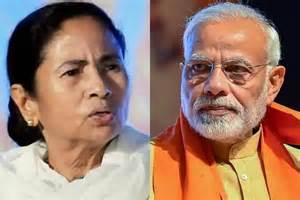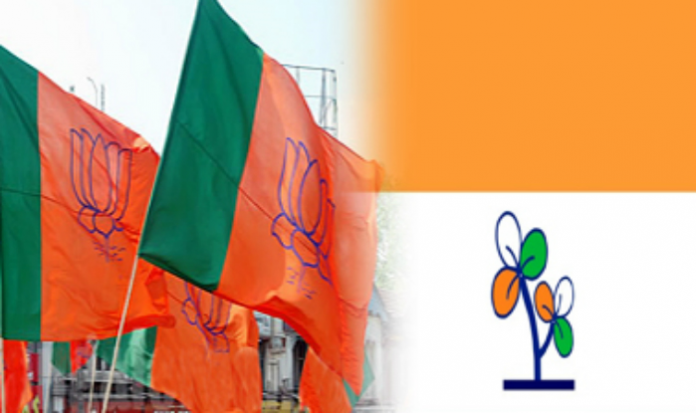By Shiveshwar Kundu
Bengal’s society can’t function without ideology. The upsurge of Hindutva in the eastern state can be seen through the aspect of an ideological vacuum created by TMC over the years.
2019 general election is a watershed moment in the Indian politics not only for any particular political party per se but for the Indian democracy itself. BJP’s phenomenal rise not only in terms of vote share but also in terms of electoral results has made many political categories redundant to understand the slippery domain of Indian politics. Amongst all the categories and its implication on the socio-political processes caste and civil society are the major two political concepts which are in a way being diluted by the Hindutva brigade. This is because irrespective of atrocities committed against the weaker caste groups it performed remarkably well in a northern belt like in Bihar and Uttar Pradesh. Secondly, Bengal’s so-called enlightened civil society which is thought to be anti-Hindutva, progressive but now seemed to embrace and welcome the Hindutva icons with zeal and enthusiasm. Traditionally, these two categories are antithetical to RSS- BJP but in this general election, they have successfully upturned the tenacity of these political categories for their own political mileage. If 2014 was the break after the long more than two decades of the coalition government, 2019 is the reinforcing of the authority of the break in the form of Modi- Shah Combine and the brand of politics they represent.
Out of all the developments, Bengal was the major focus of attention from the beginning of the electioneering process. The importance of Bengal’s result lies in the fact of Amit shah’s repeated assertion of their victory of 18 seats during the victory speech which followed the final counting. The inroads of BJP in Bengal highlights two important trends in Bengal politics. Firstly, the claim of academia that TMC hijacked the entire electioneering machinery of CPI (M) need to be relooked once again. Though they did capture but on the functional aspect, they miserably failed to replicate the methods of left front to sustain longer in the eastern state. Had it not been so BJP would not have able to shake TMC within mere eight years of their presence. Secondly, the rural area of Bengal is organized around the social formation called party society (Bhattacharya: 2009). Here, the party plays an important role in day to day life of the people of Bengal community not only in the public domain but also in the personal sphere. Left front contribution in Bengal politics is precisely it able to craft a well-structured formation of party society where the ruling party actually mediate into the day to day lives of people through its party apparatus. It was generally assumed till now that whichever political party rules Bengal its presence in the rural society in the form of a party is the prerequisite condition for its impact at the legislative as well as parliamentary level. The party generally tries to influence the socio cultural aspect of life of the people of Bengal. BJP’s whooping rise of the vote share from 17% to 40% is a kind of dent in the concept of party society which left front crafted but TMC literally destroyed that well-weaved formation. The rise of BJP can be attributed to this collapse of party society under TMC rule which eventually developed conditions for the saffron surge in West Bengal.

What explains the rise of BJP?
After the takeover in 2011, Mamata would have spent more energy and political acumen to strengthen the structure of party society to function in the long run. Though TMC captures the electioneering machinery but it fails to sustain that machinery with the zeal of ideology which left did during their tenure. The ideological strength which left front may have extracted from the popular mass movements which occurred in Bengal like Tebagha movement, operation Barga, etc. TMC doesn’t have in their kitty that sort of mass ideological milieu which would have provided sustained lubricants for the functioning of its captured machinery in the rural hinterland.
Saffron surge in Bengal exposes the ideological vacuum which TMC has created in these years. Society like Bengal which has the taste of strong socio-cultural movements can’t function without ideology which it must have missed after the decline of left. TMC’s emergence from Congress due to all forms of power struggle and its tryst with the Atal Bihari Vajpayee led NDA government is a well-known story. Neither it could take the discourse of secularism to the people nor in any of the work of TMC supremo Mamata Banerjee like Upalabdhi (realisation, 1995), Anubhuti (feelings 2002), Trinamool (1999) she developed some larger philosophical insight which could generate churning in the moment of crisis like the current one among its cadres. Passage after passage she narrates her personal story that how she has all along been victimized and how much sacrifice she has had to put up for the party. These are all fine but politics without ideology will result in sporadic manoeuvring and cacophony as is the case in the state.
It is in this ideological vacuum Hindutva consciousness creeps along with its development face of Narendra Modi. As Hindutva undoubtedly provides the option of sharp counter ideology which is in some or the other way derives its strength from the socio political process of this country. On the other hand, TMC failed to translate their rhetoric of poriborton in the form of well-crafted policy for the substantial development of the public. Instead of devising policies like Kanya Shree for empowering girls and khadya scheme which provided rice at Rs 2, TMC couldn’t provide the counter-narrative against the appeasement of Muslims i.e it didn’t come clear with their brand of secularism.
Moreover, CPI(M) is facing massive set back as far as the Bengal politics is concerned, its vote share has reduced to 7% in 2019 from 22.96% in 2014. Ideology can’t function on its own, it needs a well-structured organization to carry forward the force of ideology to the people. As far as its organization is concerned left’s organizational support is in a dilapidated state and there has been a huge shift of left toward the right (Gupta: 2019). Though CPI (M) has started to project their young guns like Shatarup Ghosh who is a well-articulated leader from south 24 pargana but this sort of projection should come from across Bengal to restrict the might of the organization like RSS which have proliferated from 1,100 shakhas in 2016 to 1, 350 shakhas in 2017 (TOI, 25March, 2018). It’s imperative not only for the Bengal politics but for the national politics too, opponents need to work at their organizational level to build their counter-narrative against BJP- RSS combine. Otherwise, very soon we have to come up with the formulation like BJP system as opposed to Congress system (Rajni Kothari) which dominated the scene of Indian politics during the 1970s.
Bengal’s public institutions
Bengalis love for public institutions is very strong and the reason for it can be attributed to the strong popular social movements from issues like the rise of tram fairs to the radical uprising like Naxal Bari which in a way foster the collective spirit in the political culture of the society. This is also glaring in the usage of public transport than private vehicles in the urban spaces of Bengal by the local people. Till left front function in this state institutions like school service commission, college service commission were efficient body which caters to the aspirations of meritorious youth in the state.
School masters were traditionally considered as the major plank which connected the community in Bengal with the ruling establishment of the state. Left front focussed on the school masters because school masters enjoys the position of eminence in the Bengal society. Common people communicate with the school masters on their day to day lives related to private and other issues, the connection of the people of Bengal with the school masters is at the psyche level. Hence they became one of the major components of party society through which Bengal’s society, as well as left front, functioned.

Mamata tremendously failed to take into confidence this section of Bengal’s society who could have acted as diesel for her administration. Irregular recruitment process by school service commission and the recent stir by the Sishu Siksha Kendras (SSK) is the major debacle which her government has failed to cope up with. This was supplemented by the ill-devised policies like declaring long vacation periods for the schools in West Bengal. Overall this creates frustration not only among the school teachers but the students too. The education sector in Bengal be it primary, high school or the higher education is in utmost crisis. There has been a massive brain drain of research scholars from the department of universities like Presidency, Jadavpur, etc. The reason being ruling government’s inability to cater for the atmosphere of swift and healthy recruitment drive which would have match the rising aspiration of youth in Bengal. Today, Bengali youth doesn’t aspire to join institutions of higher learning in Bengal which was historically the case instead they look for the opportunity outside the state.
The way forward?
It is of no doubt that Mamata resembles Modi in her approach of doing politics. This is because of two reasons, firstly, both of them swung into power by uprooting the liberal elite milieu. Modi devastated congress in centre and Mamata employed a similar tactics with the bhadralok formation of CPIM in Bengal. Secondly, both of them are populist in their orientation and their mode of functioning which goes beyond the logic of institutions. Both of them will not hesitate to break the institutional code to serve their purpose. Hence, the academia in Delhi was living an utopian dream when Mamata at the level of discourse and tactics was challenging Modi- Amit shah by unleashing whatever ammunition she had only to restrict BJP to land in Bengal. Academia was rejoicing that we found someone who can give some staunch counter to the Hindutva and force them to taste their own medicine.
This rejoicing missed the anxiety amongst the people of Bengal who are infuriated with the TMC due to their peculiar attempt of reconciling minority upliftment and welfare policies along with the steady fall of public institutions in the state. To restrict the tide of the Hindutva wave in the state TMC government should immediately return to the basics of Bengal community which can be found in the sphere of party society. To do this it has to make the public institutions functional at an exorbitant rate by minimising bureaucratic hassle and Mamata does have the capacity as well as audacity to do so.
However, it would be interesting to watch the role of left leaders in Bengal, the party needs huge restructuring at the leadership level in the form of leaders like Shatarup Ghosh before they think to revisit their organizational roots.
Shiveshwar Kundu, interested in political theory, Indian politics, social movements is pursuing research (MPhil) from the department of political science, Delhi University. He can be reached at [email protected]


